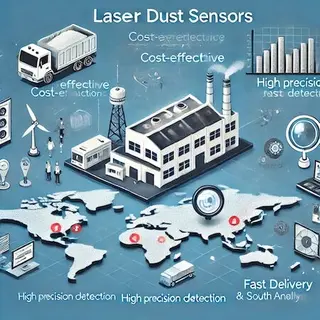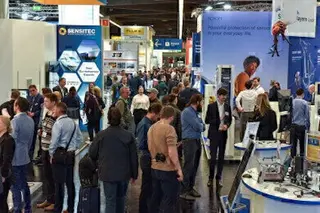How to Select a Reliable Chinese Laser Dust Sensor Supplier
On this page
The Growing Export Market for Chinese Laser Dust Sensors

Chinese laser dust sensors are gaining a competitive edge in industrial and environmental monitoring, driven by continuous advancements in research, development, and manufacturing processes. Market data shows that Chinese laser dust sensors account for approximately 30% of the global market share, a number that continues to rise annually. Major export markets for Chinese laser dust sensors include Southeast Asia, the Middle East, Africa, South America, and Eastern Europe. Rapid economic growth in these regions, coupled with an increased emphasis on environmental protection and industrial safety, has fueled demand for efficient and precise dust monitoring equipment. With ongoing improvements in accuracy, stability, intelligence, and energy efficiency, Chinese laser dust sensors are increasingly competing with products from developed countries, including those from Europe and the United States, while steadily entering the high-end market.
Advantages of Chinese Laser Dust Sensors
High Cost-Effectiveness: Chinese laser dust sensors benefit from reduced production costs by leveraging low-cost raw materials, abundant labor resources, and streamlined supply chain management. Compared to similar laser dust sensors from developed countries such as those in Europe and the United States, Chinese sensors deliver superior price competitiveness while maintaining high-quality standards. In price-sensitive markets like Southeast Asia, the Middle East, Africa, and South America, they are often the top choice for customers seeking excellent value. Additionally, Chinese manufacturers reduce unit costs through large-scale production and optimized workflows, further strengthening their position in these regions. For customers prioritizing both reliable performance and cost efficiency, Chinese laser sensors offer a compelling solution.
High-Precision Detection: Chinese sensors utilize advanced technologies such as laser scattering and spectral analysis to detect micron- and nano-level dust particles with sensitivity exceeding that of traditional sensors. This precision meets the stringent requirements of industrial dust monitoring and supports real-time detection in high-standard environments such as clean rooms and laboratories.
Customized Services and Fast Delivery: With strong technical expertise and flexible production systems, Chinese manufacturers offer tailored sensor solutions to meet specific customer needs. Customization options include sensor materials, wavelengths, data interfaces, detection ranges, and sensitivity levels, ensuring optimal performance across diverse industries and applications. By leveraging China’s robust production capacity, integrated manufacturing ecosystem, and efficient logistics systems, many suppliers complete the process from design to delivery within weeks. This rapid response capability not only shortens lead times but also helps customers capitalize on market opportunities, highlighting the strengths of Chinese manufacturing on a global scale.

High-Precision Detection: Chinese sensors utilize advanced technologies such as laser scattering and spectral analysis to detect micron- and nano-level dust particles with sensitivity exceeding that of traditional sensors. This precision meets the stringent requirements of industrial dust monitoring and supports real-time detection in high-standard environments such as clean rooms and laboratories.
Customized Services and Fast Delivery: With strong technical expertise and flexible production systems, Chinese manufacturers offer tailored sensor solutions to meet specific customer needs. Customization options include sensor materials, wavelengths, data interfaces, detection ranges, and sensitivity levels, ensuring optimal performance across diverse industries and applications. By leveraging China’s robust production capacity, integrated manufacturing ecosystem, and efficient logistics systems, many suppliers complete the process from design to delivery within weeks. This rapid response capability not only shortens lead times but also helps customers capitalize on market opportunities, highlighting the strengths of Chinese manufacturing on a global scale.
How to Source a Reliable Chinese Laser Dust Sensor Supplier
1. Use Google for Initial Research
Google is a powerful tool for identifying Chinese laser sensor suppliers. Refine your search with targeted keywords such as "China laser sensor manufacturers," "Leading laser sensor companies in China," or "Custom laser sensor suppliers in China." Search results often include links to supplier websites, industry reports, and B2B platforms. Platforms like Made-in-China, Alibaba, and Global Sources are particularly useful for researching Chinese manufacturers. These platforms provide detailed information, including product catalogs, production capacities, certifications, and customer reviews, which can help you shortlist potential suppliers. Visiting supplier websites directly allows you to assess their company profile, R&D capabilities, product offerings, and application examples. A professional, well-structured website often reflects the supplier's credibility and serves as a reliable starting point for deeper engagement.


2. Attend Laser Dust Sensor Exhibitions
 Industry exhibitions bring together leading laser dust sensor manufacturers and are excellent venues for exploring market trends and partnership opportunities. Attending these events enables direct engagement with China's top manufacturers and technical experts, providing insights into the latest advancements in laser dust sensor R&D, cutting-edge technologies, and market applications. Exhibitions also offer networking opportunities with industry peers, helping you evaluate supplier capabilities and make well-informed purchasing decisions.
Industry exhibitions bring together leading laser dust sensor manufacturers and are excellent venues for exploring market trends and partnership opportunities. Attending these events enables direct engagement with China's top manufacturers and technical experts, providing insights into the latest advancements in laser dust sensor R&D, cutting-edge technologies, and market applications. Exhibitions also offer networking opportunities with industry peers, helping you evaluate supplier capabilities and make well-informed purchasing decisions. Here are some prominent Chinese exhibitions relevant to laser dust sensors, covering fields such as optoelectronics and industrial automation:
- China International Optoelectronics Exposition (CIOE)
- LASER World of PHOTONICS China
- Shanghai International Sensor Technology and Application Exhibition (Sensor China Expo & Conference)
- Beijing International Optoelectronics Exhibition (Photonics China Expo)
- International Air Quality and Environmental Monitoring Exhibition (Indoor Air Quality Expo)
- Munich Shanghai Electronic Production Equipment Exhibition (Productronica China)
- China (Guangzhou) International Industrial Automation Technology and Equipment Exhibition (SIAF)
Evaluating the Strength of Chinese Laser Dust Sensor Suppliers
To source high-quality Chinese laser dust sensors, it is critical to thoroughly evaluate potential suppliers to ensure they align with your specific requirements. The following key factors provide a solid foundation for effective supplier assessment:
(1) Manufacturing Capabilities and Production Efficiency
Conducting on-site inspections is highly recommended to comprehensively evaluate a supplier’s manufacturing capabilities and production efficiency. Such visits provide valuable insights into their equipment, production processes, and quality control systems, helping you determine whether they can consistently deliver high-quality laser dust sensors.
- Production Equipment: Verify that the factory is equipped with advanced machinery, such as precision machining tools, laser calibrators, and automated placement systems, as these technologies enhance production efficiency and product consistency.
- R&D Capabilities: Confirm whether the supplier operates a dedicated R&D laboratory or testing center, which is crucial for validating new products prior to mass production.
- Production Capacity: Assess the supplier's ability to handle large-scale production and meet delivery schedules, even during peak demand periods.
- Quality Control: Ensure the supplier has a robust quality management system, such as ISO 9001 certification, and rigorous inspection procedures that encompass every stage, from raw material checks to final product testing, to guarantee consistent product quality.
- Delivery Capabilities: For customized products, evaluate the production timeline, including design, raw material procurement, manufacturing, and packaging. Confirm whether the supplier has the flexibility to adjust production schedules for urgent orders or large-scale demands.
By addressing these factors, you can accurately gauge a supplier’s overall capabilities and make well-informed purchasing decisions.
(2) Technical Level
Assessing a supplier's technical capabilities is a critical step in selecting a reliable laser dust sensor manufacturer. Begin by determining whether the supplier operates an independent R&D center and evaluating the size and qualifications of its R&D team. A strong R&D team is often indicative of superior competitiveness in product performance, innovation, and adaptability to market demands. Additionally, confirm whether the supplier holds patented or proprietary technologies, which reflect its technical expertise and leadership within the industry.
Practical testing is indispensable for validating product performance. Request samples to thoroughly evaluate sensor performance under diverse environmental conditions, particularly in challenging scenarios such as exposure to vibration, high temperatures, and high humidity. Focus on critical parameters, including sensitivity, measurement range, response speed, and long-term stability, to ensure the laser dust sensor aligns with your specific application requirements.
Equally vital is an assessment of the supplier's production processes and quality management systems. Verify adherence to internationally recognized standards, such as ISO 9001, and examine the rigor of its quality inspection procedures. Ensure that products undergo comprehensive testing and thorough quality checks before shipment.
A comprehensive evaluation of technical capabilities allows you to identify suppliers with robust expertise, establish a strong foundation for collaboration, and minimize potential risks associated with technical issues.
Practical testing is indispensable for validating product performance. Request samples to thoroughly evaluate sensor performance under diverse environmental conditions, particularly in challenging scenarios such as exposure to vibration, high temperatures, and high humidity. Focus on critical parameters, including sensitivity, measurement range, response speed, and long-term stability, to ensure the laser dust sensor aligns with your specific application requirements.
Equally vital is an assessment of the supplier's production processes and quality management systems. Verify adherence to internationally recognized standards, such as ISO 9001, and examine the rigor of its quality inspection procedures. Ensure that products undergo comprehensive testing and thorough quality checks before shipment.
A comprehensive evaluation of technical capabilities allows you to identify suppliers with robust expertise, establish a strong foundation for collaboration, and minimize potential risks associated with technical issues.
(3) Customization and Service Capabilities
A reliable laser dust sensor supplier should not only produce standardized products but also deliver customized solutions tailored to customers' specific needs. Customization may include adjustments to sensor size, accuracy, measurement range, interface type, or other specialized features to optimize performance in specific applications. A trustworthy supplier typically has a strong R&D team capable of adapting product designs to meet customer requirements while providing detailed technical consultations and solution optimization. Furthermore, a high-quality supplier should offer a comprehensive after-sales service system, including installation support, troubleshooting, routine maintenance, and software or firmware updates. Timely and professional after-sales service is critical to ensuring the sensor's long-term reliability and customer satisfaction.
(4) Delivery Capability
A supplier's delivery capability is a key indicator of its overall strength and reliability. Assessing delivery timelines, especially the ability to respond to urgent orders, is essential. A dependable supplier should efficiently handle large-scale orders and consistently ensure on-time delivery, even during peak periods or under special circumstances. To evaluate delivery capabilities, examine the supplier's production scheduling, inventory management, and logistics coordination processes. Additionally, familiarity with export procedures is an important aspect of delivery performance. Suppliers with international experience are typically adept at managing complex export tasks, including tariffs, transportation, and customs clearance, ensuring timely and secure delivery. In cross-border procurement, effective logistics solutions that minimize transportation time and cost can greatly improve procurement efficiency and enhance the overall customer experience.
List of Well-Known Chinese Laser Dust Sensor Manufacturers
China is home to several leading companies specializing in laser dust sensors. These companies have established themselves as high-quality suppliers in the global market through advanced technology, stringent quality control, strong production capabilities, and comprehensive after-sales services. Partnering with these suppliers ensures not only high-quality sensors but also access to professional technical support and customized solutions tailored to various application requirements.
Below is a list of notable Chinese laser dust sensor suppliers:
Below is a list of notable Chinese laser dust sensor suppliers:
- Hanrey Sensor Technology Co., Ltd.
- Yineng Technology Co., Ltd.
- Chengdu Pulse Optics-tech Co., Ltd.
- Hongda Environmental Technology Co., Ltd.
- Carey Tech Co., Ltd.
- Xingchengguang Electronics Co., Ltd.
- AkrSensor
Next: A Guide to Finding Top China Pressure Vessel Manufacturers
Previous: How to Choose a Reliable Chinese Circular Knitting Machine Manufacturer?
